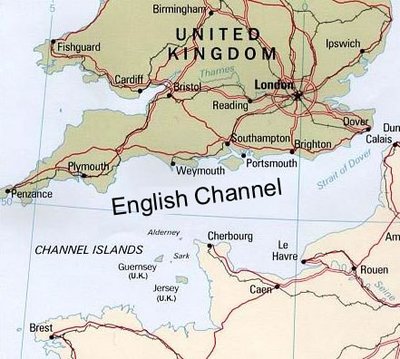English Channel
|
|
The English Channel ( French:La Manche) is the part of the Atlantic Ocean that separates the island of Great Britain from northern France, and joins the North Sea to the Atlantic Ocean. It is about 563 km (350 miles) long and at its widest is 240 km (150 miles). The Strait of Dover is the narrowest point, it being only 34 km (21 miles) from Dover to Cap Gris-Nez. The Strait of Dover (in French: Pas de Calais) is the eastern end of the English Channel, where it meets the North Sea.
The Channel Islands lie in the Channel, close to the French side. The Île d'Ouessant marks the western end of the Channel.
The French département of Manche, which incorporates the Cotentin Peninsula that juts out into the Channel, takes its name from the surrounding seaway.
| Contents |
Formation of the Channel
Before the end of the last ice age, around 10,000 years ago, the British Isles were part of mainland Europe. As the icesheet melted, a large freshwater lake formed in the southern part of what is now the North Sea. The outflow channel from the lake entered the Atlantic Ocean in the region of Dover and Calais.
At some point around 6500 BC, catastrophic erosion swept away the chalk to create the English Channel, which has since been further widened by wave action on the soft, chalk cliffs. The same mechanism continues to widen the English Channel today.
Historical significance
The Channel has been a key natural defence for Britain, a fact that is referred to in William Shakespeare's play Richard II:
English_Channel.jpg
This precious stone set in the silver sea,
Which serves it in the office of a wall
Or as a moat defensive to a house,
Against the envy of less happier lands
- –Richard II. Act 2, Scene 1.
It has allowed Britain to intervene but rarely be dangerously threatened in European conflicts. Without the gap Napoleon and Hitler would possibly have been able to overcome the powerful enemy that the British state represented.
Nevertheless, the Channel has been the scene of many invasions (or attempted invasions) including the Norman Conquest in 1066, the Spanish Armada in 1588, and the WWII Normandy landings in 1944.
The Channel has been the scene of many naval battles, including the Battle of Portland (1653), the Battle of La Hougue (1692) and the engagement between USS Kearsarge and CSS Alabama (1864).
However, at times the Channel has served as a link joining shared cultures and political structures, from pre-Roman Celtic society, the Roman imperial culture, and the foundation of Brittany by settlers from Great Britain, to the Anglo-Norman state.
Cross-Channel trade has been a significant factor for societies on both sides of the Channel from prehistoric times, and a number of important ports have developed in England and in France:
Important ferry routes are
- Dover-Calais
- Newhaven-Dieppe
- Portsmouth-Caen (Ouistreham)
- Portsmouth-Cherbourg
- Portsmouth-Le Havre
- Poole-Saint Malo
- Weymouth-Saint Malo
- Plymouth-Roscoff
Adding to the high level of cross-Channel traffic is the very significant traffic passing through the Channel, linking the economies of northern Europe with the rest of the world. Combined, this maritime traffic makes the Channel one of the busiest seaways in the world, accounting for a large share of global maritime trade (some sources place this at up to one quarter).
The coastal resorts of the Channel, such as Brighton and Deauville, inaugurated an era of aristocratic tourism in the early 19th century which developed into the democratic seaside tourism that has shaped resorts around the world.
The Channel Tunnel
Nowadays, many travellers cross the English Channel underneath, by way of the Channel tunnel or "Chunnel". This grand engineering feat, first proposed in the time of Napoleon, connects England and France by rail.
It is now routine to travel between Paris, Brussels and London on the Eurostar train.
Notable Channel crossings
On 7 January 1785 Frenchman Jean-Pierre Blanchard and American John Jeffries travelled from Dover to Calais in a gas balloon, becoming the first to cross the English Channel by air.
The first person to swim the channel was Matthew Webb in 1875. On 6 August 1926, Gertrude Ederle became the first woman to accomplish this feat, breaking the men's record of the time by two hours. This was quite a feat.
In 1909, Louis Blériot (France) was the first person to fly over the English Channel in a heavier-than-air aircraft.
In 1979, a 75-pound (34-kg) airplane called the Gossamer Albatross won the £100,000 Kremer prize for being the first human-powered airplane to fly over the Channel. The pilot Bryan Allen pedalled for 3 hours to accomplish this feat.
On 31 July 2003, Austrian skydiver Felix Baumgartner, wearing high-tech carbon wings, jumped out of a plane 30,000 feet (9 144 m) above Dover, glided over the Channel, and opened his parachute above Calais.
RBAquada.jpg
On 14 June 2004, Sir Richard Branson broke the world record for crossing the Channel in an amphibious vehicle. The Gibbs Aquada, a two-seater, open-top sports car, in which he did it, broke the record by some 6 hours.ca:Canal de la Mànega cs:Lamanšský průliv cy:Môr Udd da:Engelske kanal de:Ärmelkanal es:Canal de la Mancha eo:Manika Markolo fr:Manche (mer) id:Selat Inggris it:La Manica nl:Het Kanaal ja:イギリス海峡 nn:Den engelske kanalen no:Den engelske kanal pl:Kanał La Manche pt:Canal da Mancha sv:Engelska kanalen uk:Ла-Манш zh:英吉利海峡

